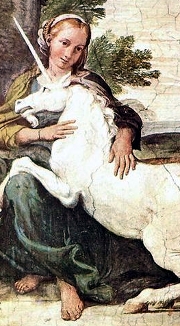 A couple posts ago, we talked about unicorns. There are other things that we pretty much know don’t exist. Some of these were deliberately invented—for example, the Flying Spaghetti Monster, sacred to Pastafarians worldwide, or the Invisible Pink Unicorn, or the new church of Kopimism.
A couple posts ago, we talked about unicorns. There are other things that we pretty much know don’t exist. Some of these were deliberately invented—for example, the Flying Spaghetti Monster, sacred to Pastafarians worldwide, or the Invisible Pink Unicorn, or the new church of Kopimism.
But before those was Bertrand Russell’s teapot.
Bertrand Russell proposed the idea of a teapot orbiting the sun between the Earth and Mars in 1952. The teapot is too small to detect with any instrument, so it’s impossible to prove this claim wrong.
Russell pushes the teapot contention to the limit:
But if I were to go on to say that, since my assertion cannot be disproved, it is intolerable presumption on the part of human reason to doubt it, I should rightly be thought to be talking nonsense. If, however, the existence of such a teapot were affirmed in ancient books, taught as the sacred truth every Sunday, and instilled into the minds of children at school, hesitation to believe in its existence would become a mark of eccentricity and entitle the doubter to the attentions of the psychiatrist in an enlightened age or of the Inquisitor in an earlier time.
How valid is the comparison of God with an orbiting teapot? We know that there are teapots, and we know how to put things into solar orbits. It’s just technology, and an orbiting teapot violates no scientific laws. But the God hypothesis is far bolder because it demands a new category, that of supernatural beings. They may exist, but science acknowledges no examples.
Is there such a teapot? Maybe, but why live as if there is? We can’t invalidate the teapot hypothesis, but that’s not the same as proving it true or even showing that it’s worthy of consideration.
We don’t give equal time to the orbiting teapot hypothesis, so why give equal time to similar claims that are equally poorly evidenced, like God?
Photo credit: Wikipedia
Related posts:
- See all the definitions in the Cross Examined Glossary.
Related links:
- “Russell’s Teapot,” Wikipedia.
- “Russell’s Teapot,” Rational Wiki.
- “Why Russell’s Teapot Still Serves,” Textuality blog, 6/29/10.

 A chapter in Carl Sagan’s The Demon-Haunted World (1995) is titled “The Dragon in My Garage.” In the spirit of Sagan’s story, here is an imagined exchange between you and me about my unicorn.
A chapter in Carl Sagan’s The Demon-Haunted World (1995) is titled “The Dragon in My Garage.” In the spirit of Sagan’s story, here is an imagined exchange between you and me about my unicorn.